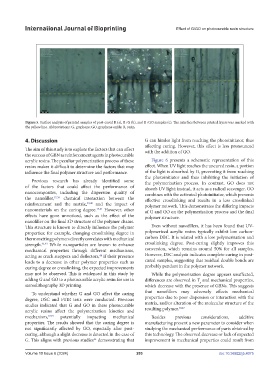Page 211 - IJB-10-6
P. 211
International Journal of Bioprinting Effect of G/GO on photocurable resin structure
Figure 5. Surface analysis of printed samples of post-cured R (a), R+G (b), and R+GO samples (c). The interface between printed layers was marked with
the yellow line. Abbreviations: G, graphene; GO, graphene oxide; R, resin.
4. Discussion G can hinder light from reaching the photoinitiator, thus
affecting curing. However, this effect is less pronounced
The aim of this study is to explore the factors that can affect with the addition of GO.
the success of GBN as reinforcement agents in photocurable
acrylic resins. The peculiar polymerization process of these Figure 6 presents a schematic representation of this
resins makes it difficult to determine the factors that may effect. When UV light reaches the uncured resin, a portion
influence the final polymer structure and performance. of the light is absorbed by G, preventing it from reaching
the photoinitiator and thus inhibiting the initiation of
Previous research has already identified some the polymerization process. In contrast, GO does not
of the factors that could affect the performance of absorb UV light; instead, it acts as a radical scavenger. GO
nanocomposites, including the dispersion quality of combines with the activated photoinitiator, which prevents
the nanofiller, 37,38 chemical interaction between the effective crosslinking and results in a less crosslinked
reinforcement and the matrix, 39,40 and the impact of polymer network. This demonstrates the differing impacts
nanomaterials on the curing degree. 17,41 However, other of G and GO on the polymerization process and the final
effects have gone unnoticed, such as the effect of the polymer structure.
nanofiller on the final 3D structure of the polymer chains.
This structure is known to directly influence the polymer Even without nanofillers, it has been found that UV-
properties; for example, changing crosslinking degree in polymerized acrylic resins typically exhibit low carbon-
thermosetting polymers directly correlates with mechanical carbon DBC. It is related with a low polymerization and
strength. 42,43 While nanoparticles are known to enhance crosslinking degree. Post-curing slightly improves this
mechanical properties through different mechanisms, conversion, which remains around 50% for all samples.
acting as crack stoppers and deflectors, if their presence However, DSC analysis indicates complete curing in post-
44
leads to a decrease in other polymer properties such as cured samples, suggesting that residual double bonds are
curing degree or crosslinking, the expected improvements probably pendant in the polymer network.
may not be observed. This is evidenced in this study by While the polymerization degree appears unaffected,
adding G and GO to a photocurable acrylic resin for use in differences are observed in T and mechanical properties,
g
stereolithography 3D printing. which decrease with the presence of GBNs. This suggests
To understand whether G and GO affect the curing that nanofillers may adversely affects mechanical
degree, DSC and FTIR tests were conducted. Previous properties due to poor dispersion or interaction with the
studies indicated that G and GO in these photocurable matrix, and/or alteration of the molecular structure of the
38,47
acrylic resins affect the polymerization kinetics and resulting polymer.
mechanism, 17,45 potentially impacting mechanical Besides previous considerations, additive
properties. The results showed that the curing degree is manufacturing present a new parameter to consider when
not significantly affected by GO, especially after post- studying the mechanical performance of parts obtained by
curing, although a slight decrease is detected in the case of this technology. The observed decrease or lack of expected
G. This aligns with previous studies demonstrating that improvement in mechanical properties could result from
46
Volume 10 Issue 6 (2024) 203 doi: 10.36922/ijb.4075

